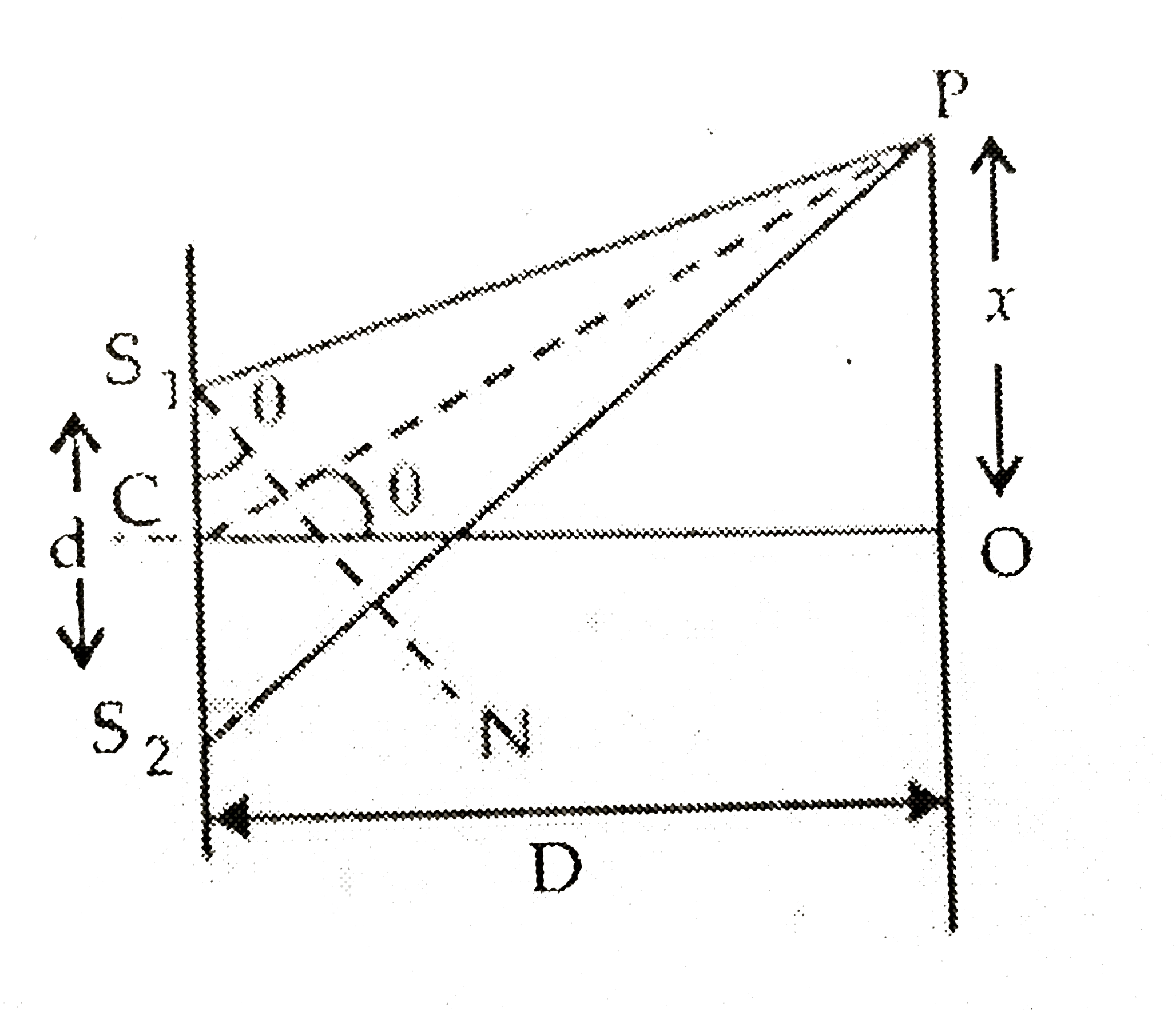(a) In Young's double slit experiment, derive the condition for (i) constructive interference and (ii) destructive interference at a point on the screen.
(b) A beam of light consisting of two wavelengths, 800 nm and 600 nm is used to obtain the interference frings in a Young's double slit experiment on a screen placed 1.4 m away. If the two slits are separated by 0.28 mm, calculate the least distance from the central bright maximum where the bright fringes of the two wavelengths coincide.
(a) Young's double slit experiment : Consider two narrow rectangular slits S1andS2 placed perpendicular to the plane of paper. Slit S is placed on the perpendicular bisector on S1S2 and illuminated with monochromatic light.
The slits are separated by a small distance d. A screen is placed at a distance D from S1,S2. Consider a point P on the screen at distance x from O. The path difference between the waves reaching P from S1andS2 is :
P=S2P−S1P
Draw S1N perpendicular to S2P. Then,
P=S2P−S1P=S2P−NP=S2N
From right-angled ΔS1S2N,S2NS2S1=sinθ
P=S2N=S2S1sinθ=dsinθ

From ΔCOP, when θ is small
sinθ≈θ≈tan θ=xD∴P=xdD
For constructive interference,
xdD=nλ,n=0,1,2,3,....
When n=0 xn=0, central bright is formed at O.
For destructive interference,
xdD=(2n+1)λ2orxn=(2n+1)λD2D=12λDd,32λDd,52λDd,...
Thus, alternate bright and dark fringers are formed on the screen.
(b) Given
λ1=800nm=800×10−9mλ1=800nm=800×10−9mλ2=600nm=600×10−9m
D=1.4m
d=0.28mm=0.28×10−3m
Let nth1 maximum corresponds to λ1 coincides with nth2 maximum corresponds λ2. Then
n1λ1Dd=n2λ2Ddor,n1n2=n2n1=600800=34
The minimum integral value of n1 is 3 and of n2 is 4. Therefore, the minimum value of y is
y mix=λ1Dd=3×800×10−9×1.40.28×10−3⇒y mix =12mm
Position of first bright fringe.
λA=800nm=800×10−9m=8×10−7m.
XA=λDd
=8×10−7
d=0.28mm,=0.28×10−3m.
D=1.4m.
XA=λDd=8×10−7×1.40.28×10−3=4×10−4×10=4×10−3M.
For wavelength λB=600nm=600×10−9m.
6×10−7 M. Position of first bright fringe is
XB=λDd=6×10−7×1.40.28×10−3=3×10−7×10−3×10=3×10−3m.
The least distance from the central maximum, where the bright fringes coincides.
=XA−XB=4×10−3−3×10−3=1×10−3m=1nm.
Topper's Solved these Questions
- XII BOARDSBook:XII BOARDS PREVIOUS YEARChapter:XII BOARDSExercise:PHYSICS (Theory) [SET - II]
Explore 6 Videos
- XII BOARDSBook:XII BOARDS PREVIOUS YEARChapter:XII BOARDSExercise:PHYSICS (Theory) [SET - III]
Explore 10 Videos
- XII BOARDSBook:XII BOARDS PREVIOUS YEARChapter:XII BOARDSExercise:[Set-III]
Explore 6 Videos
- SAMPLE PAPER 2019Book:XII BOARDS PREVIOUS YEARChapter:SAMPLE PAPER 2019Exercise:SECTION D
Explore 6 Videos
Similar Questions
(a) In Young's double-slit experiment, derive the condition for
(i) constructive interference and (ii) destructive interference ata point on the screen.
(b) A beam of light consisting of two wavelenths, 800 nm and 600 nm is used to obtain the interference fringes in a Young's double-slit experiment on a screen placed 1.4m away. if the two slits are separated by 0.28 mm, calculate the least distance from the central bright maximum where the bright fringes of the two wavelengths coincide.
View SolutionA beam of light consisting of two wavelength 800nmand600nm is used to obtain the interference fringes in YDSE on a screen held 1.4m away. If the two slits are separated by 0.28mm, calculate the least distance from thecentral bright maximum, where the bright fringes of the two waveength coincide.
View Solution
Knowledge Check
Interference fringes in Young's double slit experiment with monochromatic light are
Aalways equispacedBalways unequally spacedCboth equally and unequally spacedDformed by a portion of the wave front.In Young's double slit experiment, if one of the slit is closed fully, then in the interference pattern
A(a) A bright slit will be observed, no interference pattern will existB(b) The bright fringes will become brighterC(c) The bright fringes will become fainterD(d) None of the aboveIn Young's double slit experiment, the interference bright fringes are of:
Aequal widths and unequal intensitiesBunequal width and equal intensitiesCequal widths and equal intensitiesDunequals widths and unequal intensities
A beam of light consisting of two wavelength 800nmand600nm is used to obtain the interference fringes in YDSE on a screen held 1.4m away. If the two slits are separated by 0.28mm, calculate the least distance from thecentral bright maximum, where the bright fringes of the two waveength coincide.
View SolutionIn Young’s double slit experiment, deduce the condition for (a) constructive, and (b) destructive interference at a point on the screen. Draw a graph showing variation of intensity in the interference pattern against position ‘x’ on the screen.
View Solution(a) In Young's double slit experiment, a monochromatic source of light S is kept equidistant from the slits S1andS2. Explain the information of dark and bright fringes on the screen.
(b) A beam of light consisting of two wavelength, 650 nm and 520 nm, is used to obtain interference fringes in a Young's double - slit experiment.
(i) Find the distance of the third bright fringe on the screen from the central maximum for wavelengths 650 nm.
(ii) What is the least distance from the central maximum where the bright fringes due to both the wavelengths coincide ?
Given: The seperation between the slits is 4 mm and the distance between the screen and plane of the slits is 1.2 m.
View SolutionFind the angular fringe width in Young's double slit experiment using a monochromatic light of wavelength 500 nm when the slits are separated by 2.5 mm.
View SolutionA beam of light consisting of two wavelength 6300A∘ and λA∘ is used to obtain interference frings in a Young's double slit experiment. If 4th bright fringe of 6300A∘ coincides with 5th dark fringe of λA∘, the value of λ(inA∘) is
View Solution